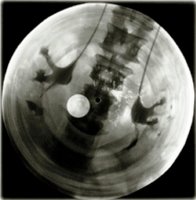 During the late 1930s and early 1940s, the most prominent sound recording equipment was the wax disk cutter. Since there was a war going on during that time, there was a lack of materials for creating records. As a result, experimentation with new materials begun and by the 1950s discarded X-ray films were used in place of records.
During the late 1930s and early 1940s, the most prominent sound recording equipment was the wax disk cutter. Since there was a war going on during that time, there was a lack of materials for creating records. As a result, experimentation with new materials begun and by the 1950s discarded X-ray films were used in place of records.Owing to the lack of recordings of Western music available in the USSR, people had to rely on records coming through Eastern Europe, where controls on records were less strict, or on the tiny influx of records from beyond the iron curtain. Such restrictions meant the number of recordings would remain small and precious. But enterprising young people with technical skills learned to duplicate records with a converted phonograph that would "press" a record using a very unusual material for the purpose; discarded x-ray plates.
This material was both plentiful and cheap, and millions of duplications of Western and Soviet groups were made and distributed by an underground roentgenizdat, or x-ray press, which is akin to the samizdat that was the notorious tradition of self-publication among banned writers in the USSR. According to rock historian Troitsky, the one-sided x-ray disks costed about one to one and a half rubles each on the black market, and lasted only a few months, as opposed to around five rubles for a two-sided vinyl disk.
By the late 50's, the officials knew about the roentgenizdat, and made it illegal in 1958. Officials took action to break up the largest ring in 1959, sending the leaders to prison, beginning an orginization by the Komsomol of "music patrols" that later undertook to curtail illegal music activity all over the country.
Link & Image: Kevin Kelly via Make
Tags: Record | X-Ray Plate | X-Ray | Music | USSR | Eastern Europe | History
Comments